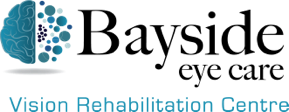Your visual system is about more than clear eyesight. Eye exams are crucial to keep your vision sharp and protect your eyes from diseases, but sometimes your vision requires more specialized treatment, like vision therapy.
One of the common questions that people ask about vision therapy is whether it is covered by OHIP (Ontario Health Insurance Plan). OHIP doesn’t cover vision therapy. However, other payment methods can help you access vital therapies to improve your visual function.
What Is Vision Therapy?
Vision therapy is a noninvasive, therapeutic approach that aims to improve eye movements, focusing abilities, and overall vision through personalized, specific exercises. It is primarily conducted by optometrists or vision therapy professionals and is often recommended for people experiencing visual conditions affecting eye muscles, such as:
- Strabismus (eye turn)
- Amblyopia (lazy eye)
However, vision therapy isn’t only for children with eye conditions. Therapeutic exercises, equipment, and tools can help with post-concussion symptoms in adolescents and adults. Working alongside physiotherapists and other health professionals, vision therapists can help reduce symptoms affecting:
- Your proprioception (balance) system
- Your vestibular system, which helps with motion and acceleration perception
With the help of vision therapy, concussion sufferers and athletes can return to their regular activities and sports safely.
What Does Vision Therapy Do?
Your vision relies on your brain and ocular systems working together to keep your eyes efficiently working as a team. For those with poor visual skills, critical vision functions are difficult, including:
- Eye tracking: the coordinated movement of the eyes following an object or scanning text while reading
- Binocular vision: how the eyes work together to maintain single vision and support depth perception
- Focusing: the eyes’ ability to shift from near to distance focus seamlessly with the eye muscles
- Spatial relationships: the ability to judge distances in relation to several moving objects
By undergoing vision therapy, you can improve your visual skills and reduce visual discomfort, such as headaches and eye strain.
How Does Vision Therapy Work?
Vision therapy works by retraining the brain and eyes to work together efficiently. It involves various exercises and activities that are designed to target specific visual skills. Therapy includes using lenses, prisms, filters, and other equipment to develop and practice visual skills.
Your optometrist will work with you to determine an effective program for your unique visual needs.
Signs Your Child Needs Vision Therapy
Your optometrist can detect strabismus or amblyopia in a children’s eye exam, but kids can display less obvious signs of vision dysfunction, including:
- An aversion to near work
- Short attention span
- Reading problems like skipping words and using their finger to track their reading
- Delayed learning of the alphabet
- Interchanging letters, numbers, or words
- Challenges with geometric shapes
- Poor hand-eye coordination
- Behavioural problems or attention disorders
What Are the Benefits of Vision Therapy?
There are numerous benefits to undergoing vision therapy. By improving your visual skills and reducing visual discomfort, you can perform various daily activities, such as reading, writing, and driving, with greater ease.
Vision therapy can also improve your work performance, sports performance, and overall quality of life. Plus, this noninvasive treatment can be completed in the comfort of your optometrist’s office.
Does OHIP Cover Vision Therapy in Ontario?
Unfortunately, OHIP does not cover vision therapy. OHIP may cover select services for children with amblyopia and strabismus. However, for adults or older children with binocular vision problems, convergence insufficiency, or post-concussion symptoms, vision therapy is considered an elective treatment option and must be paid out of pocket.
Alternative Funding Options for Vision Therapy
While OHIP doesn’t cover vision therapy, other insurance providers may provide partial or complete coverage, depending on your plan. Before starting vision therapy, it is crucial to check with your insurance provider to find out if they cover the treatment and what restrictions or regulations may be in place.
The Effectiveness of Vision Therapy
Research has shown that vision therapy can effectively improve visual conditions, focusing abilities, and binocular vision problems. Those with concussion symptoms can find relief with personalized vision therapy treatments. Many patients report significant improvement in their vision and daily functioning after completing vision therapy sessions.
However, the success of vision therapy largely depends on several factors, including the severity of your visual condition, your age, your level of motivation, and consistency in and outside of the therapy sessions.
Discover if Vision Therapy Can Help Your Visual Function
While OHIP does not cover vision therapy, it can be an effective, noninvasive treatment option for various visual conditions that impact daily life.
If you or your child are struggling with daily activities, it may be a vision problem. Consult with the doctors at Bayside Eye Care regarding the effectiveness of vision therapy for your specific visual concern. Contact us to schedule an appointment for an eye exam to start your journey to better vision.



